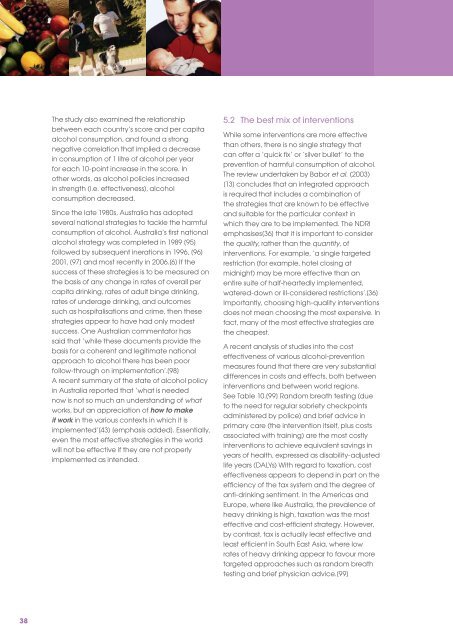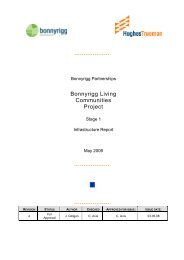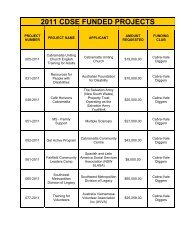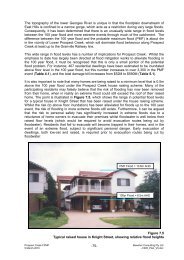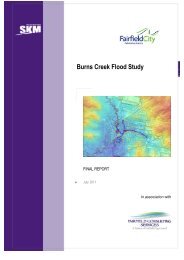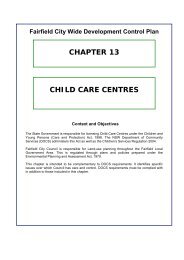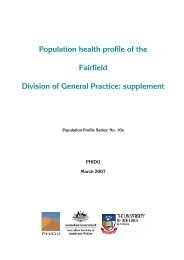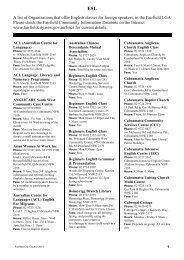Preventing Alcohol-related Harm in Australia - Department of Health
Preventing Alcohol-related Harm in Australia - Department of Health
Preventing Alcohol-related Harm in Australia - Department of Health
You also want an ePaper? Increase the reach of your titles
YUMPU automatically turns print PDFs into web optimized ePapers that Google loves.
The study also exam<strong>in</strong>ed the relationshipbetween each country’s score and per capitaalcohol consumption, and found a strongnegative correlation that implied a decrease<strong>in</strong> consumption <strong>of</strong> 1 litre <strong>of</strong> alcohol per yearfor each 10-po<strong>in</strong>t <strong>in</strong>crease <strong>in</strong> the score. Inother words, as alcohol policies <strong>in</strong>creased<strong>in</strong> strength (i.e. effectiveness), alcoholconsumption decreased.S<strong>in</strong>ce the late 1980s, <strong>Australia</strong> has adoptedseveral national strategies to tackle the harmfulconsumption <strong>of</strong> alcohol. <strong>Australia</strong>’s first nationalalcohol strategy was completed <strong>in</strong> 1989 [95]followed by subsequent <strong>in</strong>erations <strong>in</strong> 1996, [96]2001, [97] and most recently <strong>in</strong> 2006.[6] If thesuccess <strong>of</strong> these strategies is to be measured onthe basis <strong>of</strong> any change <strong>in</strong> rates <strong>of</strong> overall percapita dr<strong>in</strong>k<strong>in</strong>g, rates <strong>of</strong> adult b<strong>in</strong>ge dr<strong>in</strong>k<strong>in</strong>g,rates <strong>of</strong> underage dr<strong>in</strong>k<strong>in</strong>g, and outcomessuch as hospitalisations and crime, then thesestrategies appear to have had only modestsuccess. One <strong>Australia</strong>n commentator hassaid that ‘while these documents provide thebasis for a coherent and legitimate nationalapproach to alcohol there has been poorfollow-through on implementation’.[98]A recent summary <strong>of</strong> the state <strong>of</strong> alcohol policy<strong>in</strong> <strong>Australia</strong> reported that ‘what is needednow is not so much an understand<strong>in</strong>g <strong>of</strong> whatworks, but an appreciation <strong>of</strong> how to makeit work <strong>in</strong> the various contexts <strong>in</strong> which it isimplemented’[43] [emphasis added]. Essentially,even the most effective strategies <strong>in</strong> the worldwill not be effective if they are not properlyimplemented as <strong>in</strong>tended.5.2 The best mix <strong>of</strong> <strong>in</strong>terventionsWhile some <strong>in</strong>terventions are more effectivethan others, there is no s<strong>in</strong>gle strategy thatcan <strong>of</strong>fer a ‘quick fix’ or ‘silver bullet’ to theprevention <strong>of</strong> harmful consumption <strong>of</strong> alcohol.The review undertaken by Babor et al. (2003)[13] concludes that an <strong>in</strong>tegrated approachis required that <strong>in</strong>cludes a comb<strong>in</strong>ation <strong>of</strong>the strategies that are known to be effectiveand suitable for the particular context <strong>in</strong>which they are to be implemented. The NDRIemphasises[36] that it is important to considerthe quality, rather than the quantity, <strong>of</strong><strong>in</strong>terventions. For example, ‘a s<strong>in</strong>gle targetedrestriction (for example, hotel clos<strong>in</strong>g atmidnight) may be more effective than anentire suite <strong>of</strong> half-heartedly implemented,watered-down or ill-considered restrictions’.[36]Importantly, choos<strong>in</strong>g high-quality <strong>in</strong>terventionsdoes not mean choos<strong>in</strong>g the most expensive. Infact, many <strong>of</strong> the most effective strategies arethe cheapest.A recent analysis <strong>of</strong> studies <strong>in</strong>to the costeffectiveness <strong>of</strong> various alcohol-preventionmeasures found that there are very substantialdifferences <strong>in</strong> costs and effects, both between<strong>in</strong>terventions and between world regions.See Table 10.[99] Random breath test<strong>in</strong>g (dueto the need for regular sobriety checkpo<strong>in</strong>tsadm<strong>in</strong>istered by police) and brief advice <strong>in</strong>primary care (the <strong>in</strong>tervention itself, plus costsassociated with tra<strong>in</strong><strong>in</strong>g) are the most costly<strong>in</strong>terventions to achieve equivalent sav<strong>in</strong>gs <strong>in</strong>years <strong>of</strong> health, expressed as disability-adjustedlife years (DALYs) With regard to taxation, costeffectiveness appears to depend <strong>in</strong> part on theefficiency <strong>of</strong> the tax system and the degree <strong>of</strong>anti-dr<strong>in</strong>k<strong>in</strong>g sentiment. In the Americas andEurope, where like <strong>Australia</strong>, the prevalence <strong>of</strong>heavy dr<strong>in</strong>k<strong>in</strong>g is high, taxation was the mosteffective and cost-efficient strategy. However,by contrast, tax is actually least effective andleast efficient <strong>in</strong> South East Asia, where lowrates <strong>of</strong> heavy dr<strong>in</strong>k<strong>in</strong>g appear to favour moretargeted approaches such as random breathtest<strong>in</strong>g and brief physician advice.[99]38


